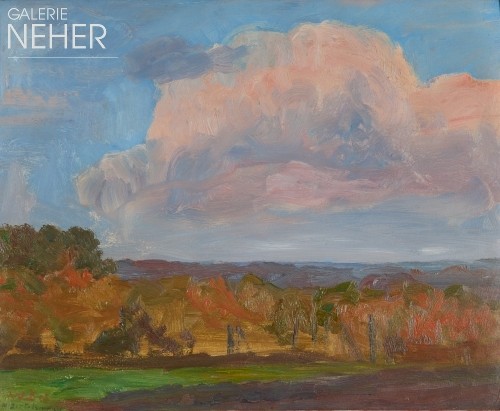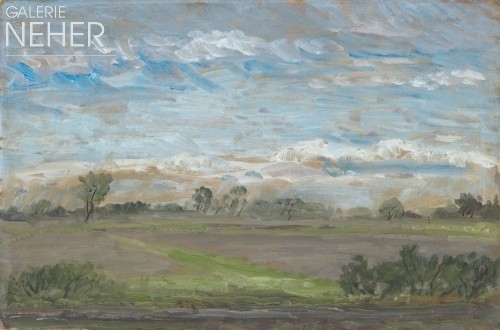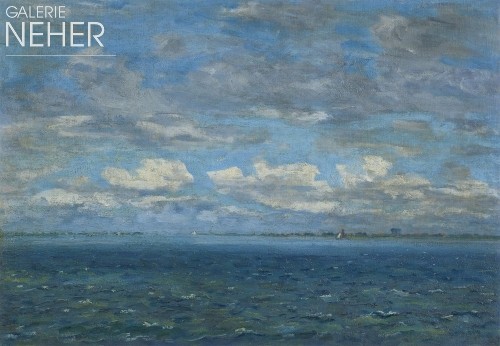Walter Bertelsmann
* 02 01 1877 | Bremen
† 11 02 1963 | Worpswede
He made his name as a northern German Impressionist and a passionate painter of water. Walter Bertelsmann is a representative of the Worpswede artist colony and maintained a connection with the village throughout his life. He captured the typical Worpswede motifs on canvas and cardboard in sensitively captured moods: the Teufelsmoor, the floods of the Hamme and Wümme, but also the Elbe and Weser, the North and Baltic Sea coasts.
Works by Walter Bertelsmann
Vita Walter Bertelsmann
1877
Born on 2 January in Bremen as the oldest of three sons of the merchant Friedrich Wilhelm Bertelsmann and his wife Sophie, née Delius.
1886–93
Attended the Altes Gymnasium in Bremen. He already liked to draw and paint during his school years. He captured ships and water in small-format watercolours and oil paintings. He visited the Kunsthalle in Bremen with his father, where he already discovered the works of the Worpswede painters in 1895.
1894
A stay at Lake Geneva for a half a year to learn French.
1895–97
Three-year apprenticeship as a tobacco merchant in Hegeler und Söhne raw tobacco factory.
1897
Volunteered for military service in the 15th Infantry Regiment in Minden/Westphalia. He was discharged early due to a diphtheria illness.
1898
Bertelsmann took on a position as an authorised representative in his father’s company, Bertelsmann und Lüderitz, and visited customers who processed tobacco in the Rhineland, in Westphalia, Saxony, Thuringia and in the Harz region as a representative, also travelling to Sweden, Norway, Denmark, England and the Netherlands. He was known to his colleagues as the “traveller with the sketchbook”.
1898–99
He took his first drawing instruction with Prof. Wilhelm Otto in Bremen.
1902
Quit his professional activity and moved to Worpswede. Bertelsmann became a pupil of Hans am Ende in November. The two painters maintained friendly contact until the death of the teacher in 1918.
1903
Acquaintanceship with the Worpswede painter Ottilie Reyländer (1882–1965).
1904
First presentation of his paintings in the Leuwer art salon in Bremen.
1905
First exhibition of three of his paintings in the Kunsthalle in Bremen.
In this early phase, his work was characterised by the classical, naturalistic style of painting of the first generation of Worpswede artists, but there was already an open and free signature and fresh colouring evident in these paintings. Like the Impressionists, he mainly worked outdoors in nature.
1905–08
Rental of the former studio of Fritz Overbeck at the sand pit on the Weyerberg.
1906
Journey to Baltrum. Here, and three years later on Wangerooge, he produced many paintings of surf and beaches.
1910
Acquaintanceship with the Hamburg painter Erna Lundbeck (1880–1956).
He was a member of the Deutscher Künstlerbund (association of German artists), at the exhibition of which in Leipzig he was represented with his painting Märzsonne (March Sun).
Bertelsmann was located at the threshold between Naturalism and Impressionism. In the following years he developed a painting style with a delicate colour harmony, light colour application, a slender brush and loose textures.
1911
Two-month stay on Sylt. Here he produced an extensive cycle of around 60 maritime pieces.
1912
Married Erna Lundbeck in April.
1913
Birth of their son Jürgen.
1915
His artistic activity was interrupted with the outbreak of the First World War. Bertelsmann was deployed on the Western Front in France, but contracted typhus in October 1916 and was admitted to the military hospital in Stenay.
1916
Birth of their daughter Hilda.
1917
Following his recovery, reassignment to a reserve battalion in Oldenburg, later to Brake.
1918
Purchase of an old farmhouse from 1785 in Worpswede. A large number of paintings of Worpswede motifs were produced, including views from the moor and flood landscapes. He often travelled by bicycle outdoors with an easel and canvas panels.
Birth of their daughter Renate.
1927
The government of Stade acquired, not least to support the artists who found themselves in financial difficulties due to inflation, paintings with typical landscape motifs, including Walter Bertelsmann’s Elbe bei Krautsand (Elbe near Krautsand) painting from the same year.
End of the 1920s
Bertelsmann undertook sailing voyages on the Lower Elbe and Lower Weser with a doctor friend, where numerous studies originated.
1930/31
Stay of several weeks in the summer with a pharmacist in Kiel. During this time, he painted motifs of the Kieler Förde (Kiel fjord), of Selenter See (Lake Selent) and from the Selent forest.
after 1933
Admission to the Reich Chamber of Culture in order to be able to continue to exhibit.
1934
Hospital stay due to severe depression.
Four-week stay on Rügen, where he produced many paintings of the beach and the steep coast.
1936
He assumed responsibility for the Worpswede municipal group of the Reichsluftschutzbund (Reich air raid protection league).
1942
His son Jürgen was reported missing as a soldier in Russia. His death was first confirmed in 1951.
1949
The couple suffered a severe emotional crisis, which made a stay in the Rockwinkel psychiatric hospital necessary.
1956
Shortly before his 80th birthday, his hometown of Bremen purchased the painting Winter auf dem Weyerberg (Winter on Weyerberg).
Death of his wife Erna on 4 July.
1957
Awarded the Cross of the Order of Merit of the Federal Republic of Germany, First Class.
1963
Bertelsmann passed away on 11 February in Worpswede.


